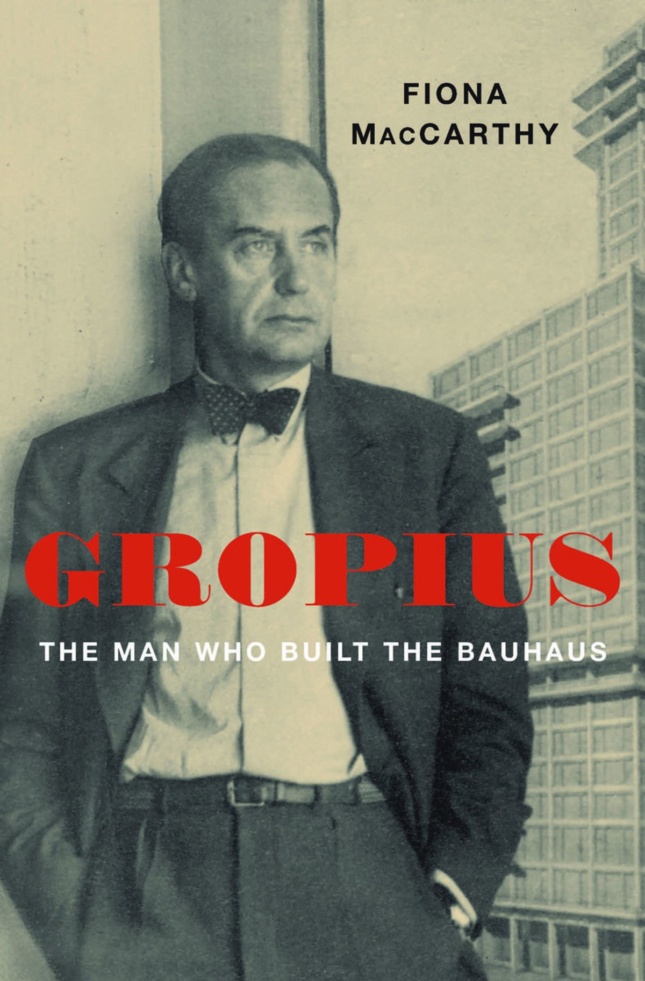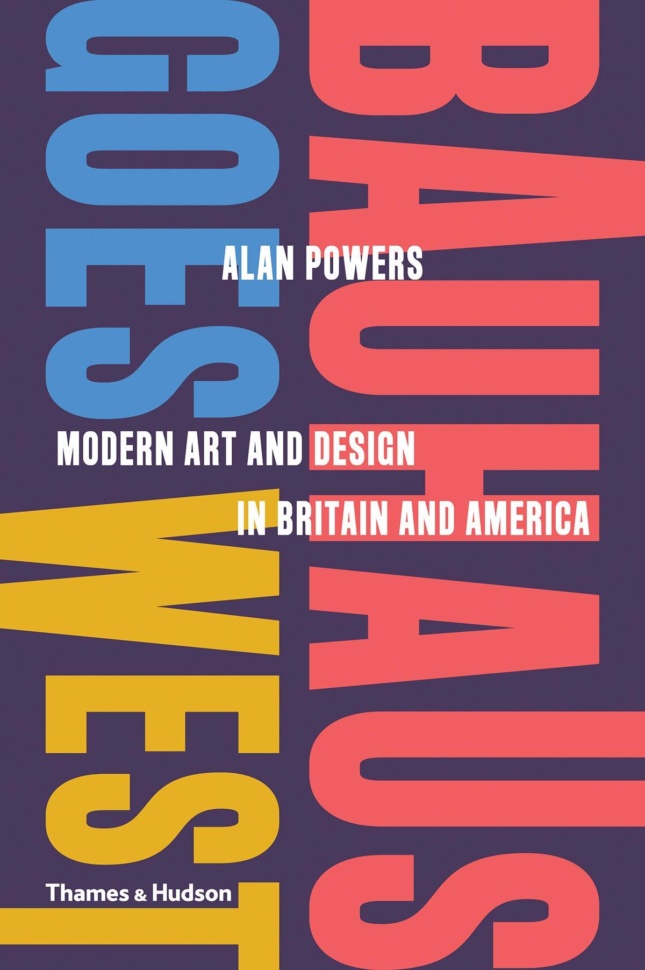Walter Gropius: The Man Who Built the Bauhaus
By Fiona MacCarthy
Harvard University Press
List Price: $35.00
Bauhaus Goes West: Modern Art and Design in Britain and America
By Alan Powers
Thames & Hudson
List Price: $40.00
“When Walter Gropius arrived in London on 18 October 1934, he was treated like a creature from another planet.” That first impression, the first sentence in the first chapter of English architectural historian Alan Powers’s enlightening study of the reception of the Bauhaus in Britain, has long prevailed. Historians have tended to see the short period that Gropius and fellow Bauhäusler Marcel Breuer, Lucia Moholy, and László Moholy-Nagy spent in London as a relatively fruitless layover on the Bauhaus’s posthumous westward march to North America (and have ignored the fact that many prominent figures also went eastward to the Soviet Union or Palestine). The New World was a land of opportunity for modernism as the United States succumbed to the genius of Gropius, whom Tom Wolfe later—riffing on Paul Klee—satirized as the movement’s “silver knight” in his 1981 book From Bauhaus to Our House. If Britain was unmoved, America was transformed, or so the oft-told tale would have it. Powers’s book is one of two new major studies that tell a different story. Gropius’s new biographer Fiona MacCarthy reports that Gropius—whom she met a year before his death—“looked back on his years in London with a kind of exasperated fondness,” while Powers argues that Britain was a far more consequential chapter in Gropius’s development as an architect than has ever been acknowledged.

Gropius founded the Bauhaus in 1919 in Weimar, but after the school lost the confidence of the local state government, it moved into its iconic modernist buildings in Dessau, only to be chased away again six years later by the local rise to power of the Nazi Party. The school eked out a final year in an abandoned telephone factory in Berlin until its third director, Ludwig Mies van der Rohe, read the graffiti on the wall and closed the school under pressure from a government now under Hitler’s command. Exile was already a condition of the Bauhaus long before the diaspora sought to re-create, in vastly different circumstances, from Moscow to Harvard, something of what had been lost.
For more than a generation, American architectural historians have set out to debunk in exhibitions and books the powerful myths of the Bauhaus’s international reincarnation that Gropius himself—with enormous help from Swiss historian and polemicist Sigfried Giedion—continually nurtured. This year the Bauhaus is celebrating its centennial, and the jury is out on whether the scholarly work of those revisionist contemporary historians is being advanced or slightly eroded. Post–Cold War Germany has a vested tourism interest in promoting the myth that all of modernist design emanated from the crucible of the Bauhaus—new museums are opening dedicated to it in Weimar and Dessau—and many of the myriad publications that accompany the festivities have set out to recharge the magnetic power of the Bauhaus as a lodestone to attract credit for almost anything modernist, especially steel architecture and metal furniture. But recent scholarship has shown just how complex and contradictory the school was during its 14-year existence as a laboratory for the most varied experimentation, and scholars continue to try to resist the pull of the Bauhaus as an easy-to-remember moniker and marketing device. Among their myriad achievements, one joint contribution of MacCarthy’s and Powers’s books is to reopen the question of what the Bauhaus diaspora brought to the U.K. and what the English sojourn contributed to Gropius’s formation, but in both books, the American part of the story feels a bit like an afterthought.
One of the dangers for those writing a biography of anyone who was at the Bauhaus is that it is tempting to treat that place as key to understanding their subject’s artistic biography from beginning to end. This reductive assumption is perhaps somewhat excusable with “the man who built the Bauhaus,” since even in America, as MacCarthy notes, Gropius kept an address book with a separate section for Bauhäusler, and set the powerful myth of his Bauhaus in motion with the 1938 show he curated at the Museum of Modern Art, intended more as a reanimation rather than a postmortem. MacCarthy is best known for her prizewinning biography of William Morris, and elements of her own biography pop up from time to time when she explains why a new biography of Gropius—a 1,200-page, two-volume account was published in 1983—is needed. She recalls a visit with Gropius to the extraordinary apartment house-cum-commune in Lawn Road near Hampstead—a modernist building designed by Wells Coates that opened in June 1934, a few months before Gropius’s emigration—as the spur that determined her to be his posthumous apologist. She writes in conscious emulation of Nikolaus Pevsner’s Pioneers of the Modern Movement: From William Morris to Walter Gropius, published in 1936, when Gropius had decided to leave for Harvard. But MacCarthy doesn’t ruminate—as Alan Powers’s book helps us to do—on what it means that a radical building like Coates’s was built in anticipation of the Bauhaus master’s arrival, not after it. MacCarthy’s appraisal of the evolution of modern architecture and design seems hardly to have advanced beyond Pevsner’s bromides in claims such as, “Without Walter Gropius’s broad-based approach to industrial designing as first developed at the Bauhaus, there might not have been an architect-designer as fluently imaginative as the American Charles Eames.”

Don’t pick up The Man Who Built the Bauhaus—a great read, suitable for the beach, which Gropius and other Bauhäusler loved, from the banks of the Elbe to Cape Cod—to bathe in Gropius’s architecture. MacCarthy has little understanding of architecture, no sense of the role that others, including Adolf Meyer and Breuer, played in Gropius’s most successful designs, and only a weak sense of his international role in the 1950s and ’60s, after he arrived in America. Despite the fact that he spent over half of his professional career in America, this period takes up only a quarter of this hefty volume. There are not even mentions of such key works as the U.S. Embassy in Athens, opened in 1961. This review could be quickly filled with a list of absences of key aspects of Gropius’s career, or misunderstandings, such as the Bauhaus building being constructed of “prefabricated concrete walls,” or the roof of Gropius and Breuer’s Frank House in Pittsburgh (1939–40) hosting a dance floor (it is in the dining room two floors below).
But this churlish assessment is to miss the point. MacCarthy’s aim lies elsewhere. In her book, we are offered an account of the sentimental journey of one of the most influential architects and pedagogues of the 20th century. The themes are of loss and absence, of the long shadow cast by Gropius’s failed first marriage to Alma Mahler and his longing for greater contact with their daughter, Manon; of the loss of the Germany he had known; of life in exile; and the troubling lack of connection with his adopted daughter, Ati (who married John M. Johansen). All this has been painstakingly and empathetically reconstructed from private letters and interviews, and finally, after the book ends with a very moving passage, MacCarthy sees Gropius as having spent his whole life fighting against that very “architectural soullessness, the despoliation of nature, the denial of community…and capitalist greed” that is still commonly held to be the legacy of modernism among Britain’s particularly virulent anti-modernists, led in recent years by Prince Charles. In the acknowledgements she offers another element of her motivation for this impressive commitment of five years of research and travel: namely, to counter Gropius’s reputation as a cold-hearted modernist and “reveal Gropius as a man of considerable passions and tenacity.” Little concrete argumentation is offered for the supposed positions in defense of nature and against capitalism by the designer of New York’s Pan Am Tower, but one goes away with something of that connection to Gropius, the man, who so moved his new biographer 50 years ago.
Bauhaus Goes West will be an eye-opener for historians and general readers alike. Powers’s main achievements are to reveal the extent to which strains of modernist experimentation existed in England before the arrival of the German and Hungarian émigrés from the Bauhaus, and also to argue convincingly that many of the key elements of their later work in America were influenced by experimentation in Britain. In a rich weave of documentation and little-known images—as opposed to the oft-reproduced photography offered in the Gropius biography—we are offered a nuanced and subtle context for the handful of years spent in London by Gropius, Breuer, and Moholy-Nagy—each of whom is given a chapter. They arrived in a country where, Powers argues, “there was a greater endorsement of a broad range of Modernism among an older generation than has been supposed,” and where a broad range of German modernism, notably the work of Bruno Taut and Erich Mendelsohn, was recognized as equally as important as the work produced at the Bauhaus. Even more important Powers underscores the radical changes that took place in modernism in the 1930s. He shows that the “romantic and regional turn in the second half of the 1930s,” in which Gropius and Breuer took part, was evident in a greater embrace of timber and structural fieldstone walls in both works that have long been part of the canon, such as Breuer and F. R. S. Yorke’s Gane’s Pavilion of 1936, and works that are great discoveries, such as a wood house by Gropius in Kent. It was in Britain that Breuer began to experiment with bent laminated plywood, which would be crucial to the transformation of American timber architecture after he joined Gropius in Cambridge, Massachusetts.
But Powers does not restrict himself to a handful of famous designers. He has researched an impressive roster of lesser-known Bauhaus émigrés and of British students who had attended the Bauhaus, and most important, he studies the work of a number of female designers, such as Enid Marx, little known outside—or even inside—Britain. Marx later wisely remarked that “the strength of the Bauhaus was not in the profundity of its technical training, but in the atmosphere of enterprise and experiments in all the arts which it managed to create.” Bauhaus Goes West is as impressive for offering a history of British textile experimentation during this period as for fully depicting a corpus of architectural statements that make it clear that modernism’s contribution to the 1930s in Britain was much more impactful than is generally acknowledged. The impact was not simply in formal terms, but also in the way that different Bauhaus figures offered different paths to explore, notably Moholy-Nagy, whose interest in the biological underpinnings of design dovetailed with scientific research in England, where the botanist A. G. Tansley coined the word “ecosystem” in 1935.
As Powers notes, then, as now, “everyone finds the version of the Bauhaus they are seeking.”
Barry Bergdoll, cocurator of the 2009 Bauhaus exhibition at MoMA, teaches architectural history at Columbia.











